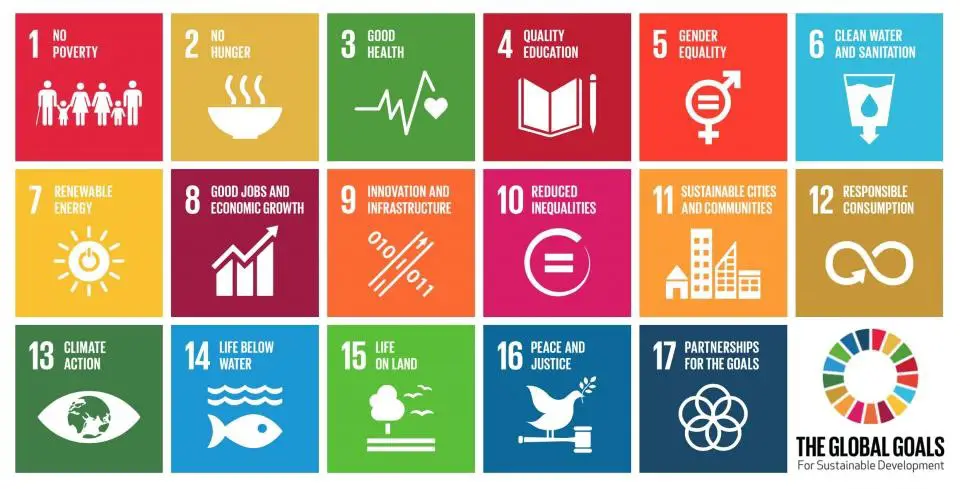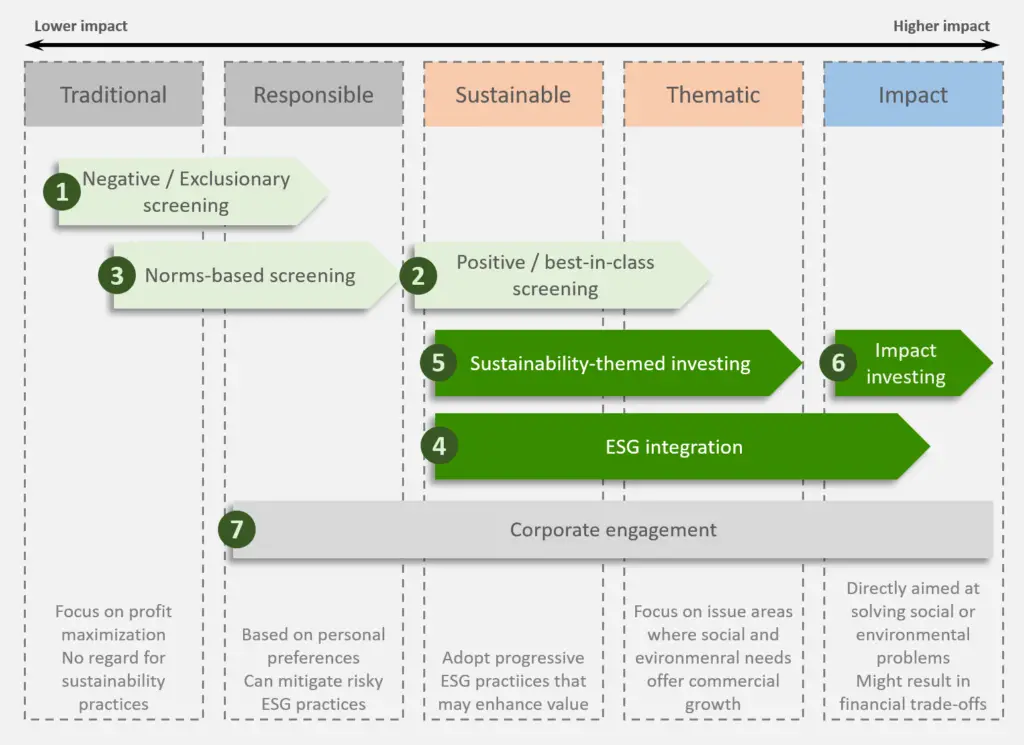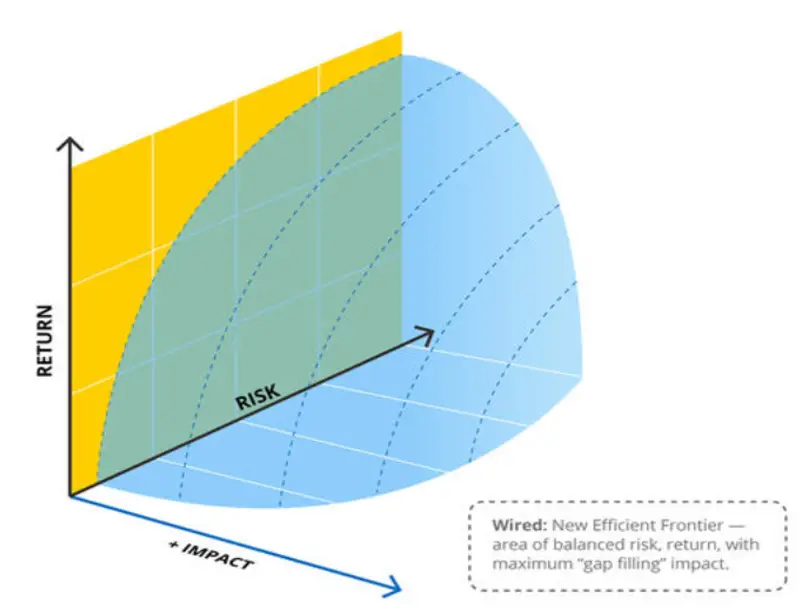How to Become a Modern Sustainable Investor in 5 Steps
In this guide we will show you why you should start with sustainable investing right now and how to become a modern sustainable investor in five steps.
- Sustainable investing definition
- How popular is sustainable investing?
- Why is sustainable investing relevant right now?
- Step 1 – Define Your Sustainable Investing Strategies
- Step 2 – Align Sustainable Investment Options with Your Risk Appetite
- Step 3 – Create and Manage your Sustainable Investment Portfolio
- Step 4 – Be Aware of Greenwashing
- Step 5 – Look for Opportunities Beyond Investing
- Conclusion
Sustainable investing definition
Sustainable investing, also referred to as sustainability themed investing, green or ethical investing is an investment strategy that focus on improving the environmental and social conditions in the world. Or at least that aims to reduce the negative impact caused on people’s lives and on the planet.
Socially Responsible Investment (SRI) is a term that gained momentum during the 1960s and 1970s, by focusing on aligning investments with investors’ concerns. During that time, SRI mainly focused on social causes such as social justice, women’s rights, and the anti-war movement. However, in more recent decades the term expanded to include environmental causes and is usually called sustainable investing. The term includes socially responsible investing, ethical or green investing, ESG (Environmental, Social and Governance), and impact investing.
How popular is sustainable investing?
Sustainable investing is gaining momentum and finally becoming mainstream. The market has doubled in the last 7 years and according to Bloomberg:
“…socially responsible investments grew by 34 percent to $30.7 trillion over the past two years, lifted by Japanese pension funds, retail investors everywhere and broad, growing concern about climate change”.
The Global Sustainable Investment Alliance (GSIA), a collaboration of membership-based sustainable investment organizations around the world, points out on their Review 2018 that Europe is the market leader in sustainable investments with USD 14 trillion worth of assets. Followed closely by the United States with USD 12 trillion worth of assets.
| Region | 2016 | 2018 |
|---|---|---|
| Europe | 12,040 | 14,075 |
| United States | 8,725 | 11,995 |
| Japan | 474 | 2,180 |
| Canada | 1,086 | 1,699 |
| Australia / New Zealand | 516 | 734 |
| Total | 22,841 | 30,683 |
Why is sustainable investing relevant right now?
It might not be news that sustainability is becoming an urgent issue to be addressed by companies, governments, and society in general. By now you should be familiar with the Paris Agreement signed in 2015 and the 17 Sustainable Development Goals (SDGs), which have a deadline in 2030!

However, five years after the Paris Agreement, the SDGs are way off track. Actually, at the Sustainable Development Goals Progress Chart 2019 we can see that globally, except for “Goal 8 – Sustain per capita economic growth”, all other goals and targets are off track. They either require acceleration (yellow), have made limited or no progress (orange) or are moving away from the target / in deterioration (red). There is a persistent financial gap of USD 2.5 trillion per year, that needs to be invested in the SDG to achieve the 17 goals by 2030.
That is where you and Your Green Wealth come into the picture. We all need to act together. Governments, corporations, and society. Domestic, international, public, and private capital needs to be directed to relevant and critical areas to support the SDGs. These include large institutional investors and small individual investors, like you.
In the following 5 steps, we will guide you on how to start investing sustainably and how to become a modern sustainable investor.
Step 1 – Define Your Sustainable Investing Strategies
The Global Sustainable Investment Alliance (GSIA) has a clear definition of sustainable investing strategies. When investing sustainably, investors can choose a combination of the following investing strategies:
- Negative/exclusionary screening
- Positive/best-in-class screening
- Norms-based screening
- ESG integration
- Sustainability-themed investing
- Impact investing
- Corporate engagement
Below you can see the official definition from GSIA and examples of investments:
| Strategy | Definition | Example |
|---|---|---|
| Negative/exclusionary screening | Exclusion of certain sectors, practices or companies from the investable universe | Avoiding controversial activities (weapons, nuclear weapons, thermal coal, tobacco, civilian firearms, tobacco, and oil sands) |
| Positive/best-in-class screening | Including companies and projects that have a superior ESG performance relative to their peers | Increase portfolio weight of stocks with high ESG scores or screened ETFs |
| Norms-based screening | Exclusion of companies and projects with a business practice not in line with international norms | Exclude companies that violate UN Global Compact, OECD, International Labour Organisation, UN and UNICEF |
| ESG integration | Explicit and systematic inclusion of ESG risks and opportunities in financial analysis and investment decision making | Selecting only investments high ESG scores |
| Sustainability-themed investing | Investing in themes and economic activities that are related to sustainability | Clean energy, green technology, or sustainable agriculture |
| Impact investing | Investments directly aimed at solving social or environmental problems | Capital is specifically directed to traditionally underserved individuals or communities, as well as financing that is provided to businesses with a clear social or environmental purpose |
| Corporate engagement | Active shareholder engagement with companies to influence their corporate behavior on ESG issues | Communicating with senior management and/or boards of companies, filing or co-filing shareholder proposals, and proxy voting that is guided by comprehensive ESG guidelines |
The seven sustainable investing strategies can be placed at the impact investing spectrum of capital (below), which goes from traditional investing (left side, low impact) to pure impact investing (right side, high impact). The GSIA investing strategies are placed according to the level of positive impact that each one of them can bring to people and the environment.

From the seven investment strategies above, ‘Negative/exclusionary screening’ and ‘ESG integration’ are the most common in the investment market, representing 2/3 of total asset allocation.
Impact investing, the investment strategy with potentially the highest impact on the environment and society, is still the least preferred among investors, with roughly only half a trillion USD of assets under management.
Step 2 – Align Sustainable Investment Options with Your Risk Appetite
Before rushing to create a sustainable investment strategy and allocating your money to different investment products, it is important to understand the different asset classes and associated risks.
Green, Social and Sustainable bonds
- What is it: fixed income assets with fixed interest rates. Green, Social, and Sustainable bonds can be issued by corporations and governments and the proceeds are exclusively applied to eligible environmental and social projects.
- Product example: iShares Global Green Bond ETF (BGRN)
- Risk level: very low – government bonds have a lower risk than corporate bonds
Equity investing at listed companies
- What is it: investing via the traditional stock market, either through stock-picking, ETFs, or index funds is a way to allocate your money on relatively secure assets. Listed companies are of medium and large sizes and need to keep good transparency of their activities and publish public reports on a quarterly and yearly basis. Most listed companies have profit and shareholder satisfaction as their main objective and purpose, leaving environmental and social impacts as a secondary focus.
- Product example: iShares MSCI World SRI UCITS ETF (SUSW) and Vanguard ESG U.S. Stock ETF (ESGV)
- Risk level: low to medium – subject to fluctuation of listed companies’ performance and economy fluctuations
Peer-to-Peer (P2P) Lending or Crowdlending
- What is it: debt or loan investing via crowdlending platforms that connect borrowers directly to individual investors. This enables investors to support small businesses, entrepreneurs and, communities directly or indirectly.
- Product example: Trine, Lendahand, GoParity, Miris X, Energise Africa
- Risk level: high – risk of losing principal and interests in case of loan default or platform insolvency
Crowdfunding (equity investing in startups or SMEs)
- What is it: funding a project or venture by injecting equity into startups or SMEs. Enable investors to invest directly in green and ethical startups using crowdfunding platforms.
- Product example: Seedrs and Funderbeam
- Risk level: very high – risk of losing original capital and returns are subject to high volatility due to the early nature of the startups and SMEs.
Invest with Seedrs and get £25 free investment credit
Step 3 – Create and Manage your Sustainable Investment Portfolio
Once you have selected your sustainable investing strategy and respective asset classes, it is time to start creating your investment portfolio.
A sustainable portfolio should be created almost in similar ways as a standard or “non-sustainable” investment portfolio. It should consider the investing time horizon, diversification of investments, and investor risk tolerance. However, one new variable should be considered: Impact. Sustainable investors should aim to balance their portfolios around risk, return, and impact.
One way of visualizing this is presented in the 3-axis diagram below. Impact as a third dimension was first introduced by Brian Dunn at the “Modern Portfolio Theory – with a Twist”. Sustainable investors should be able to measure and account for the impact of their investments. They need to go beyond the traditional risk/return assessment, evaluating how their investment choices are bringing the optimal positive impact on the environment and society.
Ultimately, sustainable investors should strive for a portfolio that maximizes return and impact while minimizing risk.

Lack of industry consensus
Frameworks to assess the impact of investments are currently maturing phase and are constantly being improved by the investment industry. Thus, sustainable investors should expect to find some difficulties when assessing the impact of sustainable investments, and consequently, the impact of the whole investment portfolio.
As an example, looking at ESG (most widely used sustainable framework), there are more than 125 ESG data providers. Among those are well-known rating agencies with global coverage, such as Bloomberg, FTSE, MSCI, Sustainalytics, Thomson Reuters, and Vigeo EIRIS. However, there is no established industry consensus on data sourcing, weighting, and scoring of ESG factors.
According to State Street, there is a clear “lack of standardization and transparency in providers’ data collection and scoring methodologies pose key challenges for investors”.
Disclosure of ESG by companies is non-mandatory and not regulated. It is often a one-way communication, where the companies themselves disclose their ESG performance without being audited by third parties.
Despite the challenge of assessing impact, the European Commission has taken a first step in regulating the ESG practices, including the Non-Financial Reporting Directive, Sustainability-Related Disclosures Regulation, and Taxonomy Regulation, among other measures.
Sustainable Investment Portfolio Allocation
The easiest way to start with your sustainable portfolio is to replace your current investments with green and sustainable alternatives. For example, if you have 40% of your portfolio invested in equities (ETFs and companies’ stocks), you can replace those with a sustainable equivalent (e.g. ESG ETFs and high-ranked ESG companies).
The same can be implemented for your bonds, replacing them with green or sustainable bond. And if you have more risky investments such as crowdlending and crowdfunding, you can look for sustainable alternatives to them (e.g. impact platforms and impact startups)
Despite the growing number of sustainable financial options on the market, by cleaning your portfolio your diversification may be reduced. You will no longer be exposed to the whole market and consequently, your risk exposure will be affected, since you will be leaving full industries out of your portfolio (e.g. Oil & Gas, Tobacco). Make sure that this “reduction in diversification” is aligned with your risk appetite and personal values.
Step 4 – Be Aware of Greenwashing
The recent trend in sustainable investment and the growth of ‘ESG’ products in the investment market can lead to unethical practices from corporations, taking advantage of the wave. An example of this is greenwashing, the act of providing false or misleading information about how companies’ products or services are sustainable or environmentally friendly.
Sustainable investors should be aware that some investment products (e.g. funds, ETFs, or stocks) might not be as sustainable as they claim. This is more critical for investment funds, where the fund holdings might not always be as sustainable as expected, or not fully transparent about where the money is being invested (e.g. mutual funds).
Greenwashing can be a complex topic and difficult to identify for the less experienced investor. We have a post about how to spot, identify and avoid companies and funds that are not truly or fully sustainable.
Step 5 – Look for Opportunities Beyond Investing
In case you already have a fully sustainable portfolio or if you still need more time to make your decision before transitioning into sustainable investments, there are other, less capital intensive, alternatives.
Those options will probably require less capital than traditional investment opportunities. They should represent a smaller fraction of your portfolio; however, they will also have a lower impact.
Offsetting your carbon footprint: you can allocate your money into carbon offsetting initiatives, compensating for your carbon emissions. On average one person emits 4.8 tons of CO2 per year. However, if you are from the US your carbon footprint is almost 4x the world average, at 16.6 tons of CO2 per year!
Even for an American, the cost of offsetting the carbon footprint of one person will not be more than USD 100 – 200 per year. However, you can go beyond that and decide to either invest or donate, more than your carbon footprint share, to companies that offset carbon dioxide emission.
Become a sustainability activist: you can focus your efforts on dedicating your time or allocating money towards causes that you care about the most. Those can be of social or environmental nature.
However, beyond donating to traditional well-known global movements (e.g. Greenpeace, Red Cross) you can focus regionally and, for example, put pressure on your pension fund to make investments that matter to you and your colleagues (e.g. Make My Money Matter in the UK)
Impact philanthropy: Lastly you can simply donate your money to causes that you care about and that are aligned with the Sustainable Development Goals. Givewell is a charity that performs in-depth research to find highly effective charities around the world and donates your money to the ones that have the highest impact.
Conclusion
Sustainable investors have plenty of options in the financial markets to start allocating their capital in corporations, governments, and SMEs that are positively impacting the environment and society and making a real difference.
The large number of investment options available allow for the creation of a sufficiently diversified sustainable portfolio, still aiming to replicate investors’ risk profile, time horizon, and return ambitions.
It is true that adding impact as the third dimension to portfolio management adds complexity and might require higher dedication from investors when assessing and selecting investment options. However, the additional effort and due diligence needed are compensated by making the right decision when investing your money.
This guide provides you with 5 simple steps to start with sustainable investing and become a modern sustainable investor. At Your Green Wealth, we will keep supporting you with more insightful information and tools to facilitate your decision-making process.
Let us know if you would like to know more about sustainable investing.
Not investment advice: The information provided on this website is intended for general information purposes only and does not constitute investment advice, financial advice, trading advice, or any other sort of advice. You should conduct your due diligence and, if necessary, consult a qualified independent financial advisor before making any investment decision.
Disclaimer: This website may use affiliate links. Keep in mind that we may receive commissions when you click our links and make purchases.



